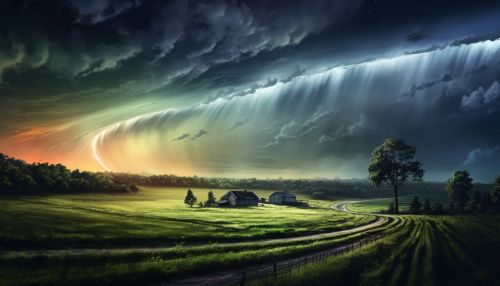Tornado
Introduction
A tornado is a rapidly rotating column of air that is in contact with both the surface of the Earth and a cumulonimbus cloud or, in rare cases, the base of a cumulus cloud. The strongest tornadoes can produce intense winds with a speed of over 300 miles per hour. These natural phenomena are often referred to as twisters or cyclones, although the word cyclone is used in meteorology in a wider sense, to name any closed low pressure circulation.
Characteristics
Tornadoes come in many shapes and sizes, but are typically in the form of a visible condensation funnel, whose narrow end touches the Earth and is often encircled by a cloud of debris and dust. Most tornadoes have wind speeds less than 110 miles per hour, are approximately 250 feet across, and travel a few miles before dissipating. The most extreme tornadoes can attain wind speeds of more than 300 miles per hour, stretch more than two miles across, and stay on the ground for dozens of miles.


Formation
Tornadoes form in severe thunderstorms. The first step in the formation of a tornado is the creation of a thunderstorm. However, not all thunderstorms produce tornadoes, as specific conditions are required. The thunderstorm must be "severe", meaning it must be capable of producing hail. The storm must also occur in an environment with significant vertical wind shear, which is the change in wind speed and/or direction with height. This wind shear is crucial in the formation of a rotating updraft, or mesocyclone, which is the precursor to a tornado.
Types of Tornadoes
There are several types of tornadoes, including the multiple vortex tornado, landspout, waterspout, and the most powerful and destructive of all, the supercell tornado.
Multiple Vortex Tornado
A multiple vortex tornado is a type of tornado in which two or more columns of spinning air rotate around a common center. This is different from a single vortex tornado, where only one column of air is spinning. Multiple vortex tornadoes can be extremely destructive.
Landspout
A landspout, or a dust-tube tornado, is a tornado not associated with a mesocyclone. The name "landspout" was created as an analog to waterspout, to distinguish tornadoes that form over land.
Waterspout
A waterspout is defined by the National Weather Service as a tornado over water. However, researchers typically distinguish "fair weather" waterspouts from tornadic waterspouts. Fair weather waterspouts are less severe but far more common, and are associated with developing storm systems.
Supercell Tornado
A supercell tornado is the most powerful and destructive type of tornado. These tornadoes form in supercell thunderstorms, which are large, powerful thunderstorms that have a rotating updraft.
Tornado Alley
Tornado Alley is a colloquial term for the area of the United States where tornadoes are most frequent. The term was first used in 1952 as the title of a research project to study severe weather in areas of Texas, Louisiana, Oklahoma, Kansas, South Dakota, Iowa and Nebraska. Tornado climatology studies have shown that most of the world's tornadoes occur in the central United States, primarily in the area known as Tornado Alley, due to the unique geography of the Great Plains.
Tornado Intensity and Damage
The intensity and damage caused by tornadoes are measured by the Enhanced Fujita scale (EF Scale), which replaced the older Fujita scale in the United States in 2007. The EF Scale, which is also used in most of North America, was updated to reflect better examinations of tornado damage surveys, so as to align wind speeds more closely with associated storm damage. The scale now has 28 damage indicators, each with a varying number of degrees of damage.
Safety Precautions
When a tornado warning is issued, it is important to take shelter immediately. Basements, storm cellars, and small interior rooms on the lowest floor of a building are the safest places to be. If these are not available, a small, windowless hallway on the lowest level of the house is the next best option. It is also recommended to cover yourself with a mattress or heavy blankets to protect against flying debris.
